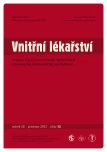Current guidelines on the care of tunelized vascular catheters in patients on home parenteral nutrition
Authors:
J. Víšek; J. Maňák; R. Šafránek; M. Kubišová; R. Dlouhá; L. Sobotka; V. Bláha
Authors‘ workplace:
III. interní gerontometabolická klinika Lékařské fakulty UK a FN Hradec Králové, přednosta prof. MUDr. Luboš Sobotka, CSc.
Published in:
Vnitř Lék 2012; 58(12): 955-957
Category:
Review
Overview
Home parenteral nutrition is the only option to provide nutrition in a number of patients. Care of venous entry, its management and treatment of complications resulting from its use importantly affect patient survival. Appropriate care of the catheter and the use of current knowledge may prolong the lifespan of the catheter, reduce patient morbidity and mortality and thus increase quality of life of patients who are dependent on home parenteral nutrition. The present paper summarizes recommendations for the care of long-term venous catheters.
Key words:
parenteral nutrition – catheter infection – antibiotic lock
Sources
1. Pittiruti M, Hamilton H, Biffi R et al. ESPEN Guidelines on Parenteral Nutrition: central venous catheters (access, care, diagnosis and therapy of complications). Clin Nutr 2009; 28 : 365–377.
2. Mimoz O, Pieroni L, Lawrence C et al. Prospective, randomized trial of two antiseptic solutions for prevention of central venous or arterial catheter colonization and infection in intensive care unit patients. Crit Care Med 1996; 24 : 1818–1823.
3. Bozzetti F, Mariani L, Bertinet DB et al. Central venous catheter complications in 447 patients on home parenteral nutrition: an analysis of over 100.000 catheter days. Clin Nutr 2002; 21 : 475–485.
4. Zapletal O, Blatný J, Štarha J. Heparinem indukovaná trombocytopenie při léčbě nízkomolekulárními hepariny u dětí. Je čeho se obávat? Vnitř Lék 2010; 56: (Suppl 1): 55–57.
5. Staun M, Pironi L, Bozzetti F et al. ESPEN Guidelines on Parenteral Nutrition: Home Parenteral Nutrition (HPN) in adult patients. Clin Nutr 2009; 28 : 467–479.
6. Pronovost P, Needham D, Berenholtz S et al. An intervention to decrease catheter-related bloodstream infections in the ICU. N Engl J Med 2006; 355 : 2725–2732.
7. Vanholder R, Canaud B, Fluck R et al. Diagnosis, prevention and treatment of haemodialysis catheter-related blood stream infections (CRBSI): a position statement of European Renal Best Practice (ERBP). NDT Plus 2010; 3 : 234–246.
8. Mermel LA, Allon M, Bouza E et al. Clinical practice guidelines for the diagnosis and management of intravascular catheter-related infection: 2009 update by the Infectious Diseases Society of America. Clin Infect Dis 2009; 49 : 1–45.
9. Oliveira C, Nasr A, Brindle M, Wales PW. Ethanol Locks to Prevent Catheter-Related Bloodstream Infections in Parenteral Nutrition: A Meta-Analysis. Pediatrics 2012; 129 : 318–329.
10. Sherertz RJ, Boger MS, Collins CA, Mason L, Raad II. Comparative in vitro efficacies of various catheter lock solutions. Antimicrob Agents Chemother 2006; 50 : 1865–1868.
11. Touré A, Lauverjat M, Peraldi C et al. Taurolidine lock solution in the secondary prevention of central venous catheter--associated bloodstream infection in home parenteral nutrition patients. Clinical Nutr 2012; 31 : 567–570.
Labels
Diabetology Endocrinology Internal medicineArticle was published in
Internal Medicine

2012 Issue 12
Most read in this issue
- Arterial hypertension in gravidity – a risk factor for cardiovascular diseases
- Current opinions on gout, its diagnosis and treatment
- Current guidelines on the care of tunelized vascular catheters in patients on home parenteral nutrition
- Is antiplatelet therapy always effective?
